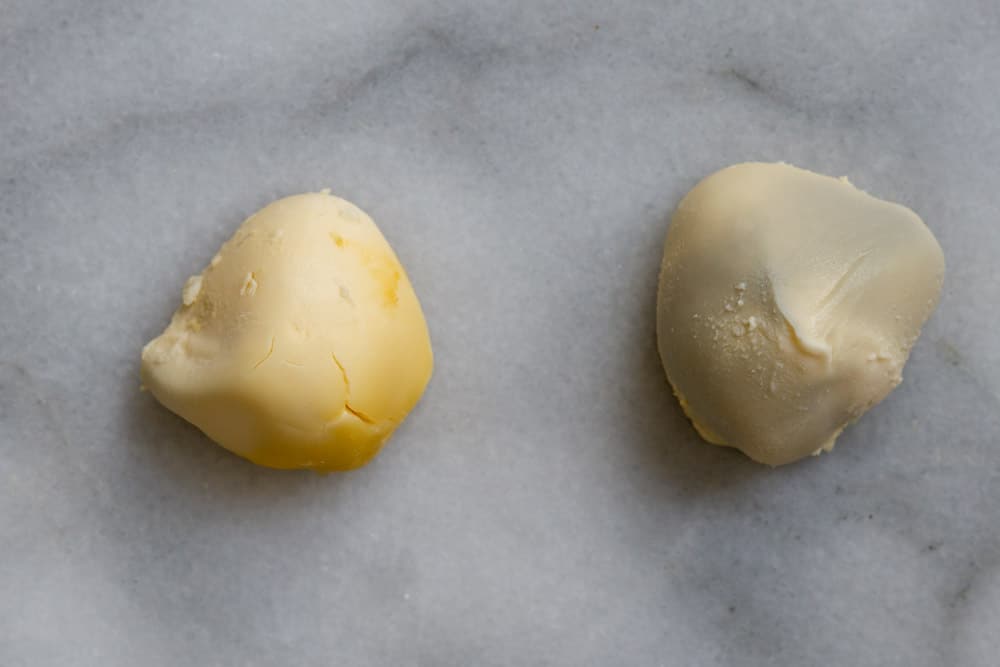Learn the science behind:

Why Do Hard-Boiled Eggs Have Grey Yolks?
Just wanted to eat a hard-boiled egg and found out that it contains a dark grey ring around the yolk? No need to throw it out, these grey egg yolks are still perfectly safe to eat. They just don’t look that appealing anymore. Want to prevent it from happening again? Then it helps to know what caused it.
The dark grey color forms because of a simple chemical reaction within the egg. The good news? It can be prevented quite easily!
A dark ring surrounds the yolk
Next time you encounter a grey egg yolk, have a closer look. Where exactly has your egg turned grey, or even blue/greenish?
You’ll find that it’s the outer layer of the yolk, the part that sits snuggly within the egg white. The change in color always occurs at this intersection. That provides us with a major clue as to what’s going on. Apparently, both the yolk and the white are required for the color change of the yolk to occur.
A chemical reaction turns the yolk grey
So what is that grey, or even black color?
It’s not a living thing, instead, it’s a compound, called ferrous sulfide, also referred to as iron sulfide or FeS. This compound can be formed through a chemical reaction between: iron and hydrogen sulfide.
Yolk supplies the iron
The yolk of an egg contains a lot of vitamins and minerals. If the egg had been fertilized, the new chicken would have needed these to develop into a healthy animal. One of the many minerals in yolks is iron. There’s enough iron in the yolk that can react to form a complete grey layer around the yolk.
Sulfur comes from the white
Both the egg white and the egg yolk contain sulfur. Under the right conditions, this sulfur can form the gas hydrogen sulfide. Scientists found that this only happens to a reasonable degree in egg whites. Egg yolks barely develop any hydrogen sulfide. The hydrogen sulfide is quite reactive and will react with the iron, to form the grey-colored iron sulfide.
Reaction requires heat
But, not all boiled eggs develop this dark grey ring. It’s because for the reaction to occur, the temperature needs to be high enough, for a long enough period of time. Only then enough hydrogen sulfide gas is formed and can the reaction take place.
It seems that it needs to be at least 70°C (158°F). From this point onwards, the hotter it is, the faster the reaction will proceed, thus the darker colored the egg. Keep in mind though that when boiling an egg, it takes a while for the center of the egg to even get to 70°C (158°F). However, once it’s hot, it will remain hot enough for some time.
How to prevent a grey egg yolk
Now that we know that the grey/green/blue color of the yolk is caused by a chemical reaction, we know how to prevent it from happening!
The solution here is quite simple: it is all about temperature control. The longer the outside of your egg yolk is hot, the more likely it is to turn grey. So, do not overcook your egg.
Do not overcook the egg!

How to fix a grey egg yolk
Still overcooked your eggs and ended up with a grey egg yolk? If you’d like to fix it, you can. The grey color isn’t stable. As a matter of fact, if it’s exposed to air for long enough, it will slowly disappear again!
Of course, this does require you to cut open the eggs, and take out the yolks, to ensure they have access to air. But, if you do, it works. It might not be practical or worth your time though…

References
Chest of Books, The Formation Of Ferrous Sulfide In Cooked Eggs, link
Exploratorium, Do you know how to hard cook an egg?, link
Puchina, Iron (II) sulphide from boiled egg, April-21, 2019, Microcosmos, link
Charles Kenneth Tinkler and Marion Crossland Soar, THE FORMATION OF FERROUS SULPHIDE
IN EGGS DURING COOKING, From the Chemical Laboratory, Household and Social Science
Department, King’s College for Women, 1920, p. 114-119, link
Wikipedia, Iron sulfide, link
What's your challenge?
Struggling with your food product or production process? Not sure where to start and what to do? Or are you struggling to find and maintain the right expertise and knowledge in your food business?
That's where I might be able to help. Fill out a quick form to request a 30 minute discovery call so we can discuss your challenges. By the end, you'll know if, and how I might be able to help.






thank you for this blog!!! really appreciating you sharing knowledge bout food with science.
Glad to hear you found it useful!
Thank you for that explanation. I cooked 14 eggs in my instantpot and 4 of them were gray and the rest were yellow. If it was overcooking only, then they all would have been colored. Some of the eggs were older than the others. Next time I will put a mark on the older eggs to see if this happens again.
Would love to hear whether indeed the older ones got gray! Else we’ll have some more digging to do. Thanks for sharing.
thank you!!😊this blog really helped me with my science assignment!!
Really enjoyed this article. Somthing I’ve actually wondered about. I’m not a H.B. egg lover, and some of that actually came from me not liking that color change. I felt like the eggs were bad. The discoloration combined w a sulfur odor made feel like the eggs were tainted. It all makes too much sense now. Crazy how stumbling onto an article can answer questions you had no idea you needed the answer to. I love the chemistry angle to it all as well. I still think the only times I will be consuming H.B. eggs is in or on a Cesar salad.